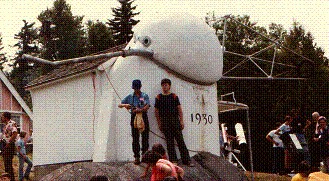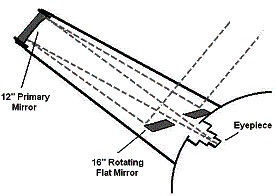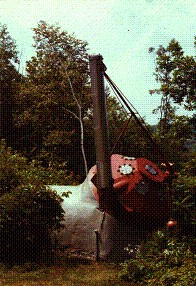Porter Turret Telescopes
Jack Kramer
With the coming of cold winter nights, we often think how nice it would be to observe from a sheltered environment. One solution was developed by Russell Porter, an engineer, architect, arctic explorer, telescope maker, and artist who contributed to the design of the 200-inch Mount Palomar telescope. His home in Vermont motivated him to come to grips with harsh winters. To enhance personal observing comfort, Porter designed telescopes that take a totally novel approach.
Porter's theory was to provide protection for the observer while keeping most of the telescope optics outside, where they would be less affected by the air currents that plague traditional observatory structures. One telescope that you may have seen pictured is the Porter Turret Telescope situated on the site of the annual Stellafane Convention on Breezy Hill, just outside of Springfield, Vermont. This telescope was built in 1930 for the Springfield Telescope Makers. That club inaugurated the Stellafane convention, which continues today as the oldest annual convention of amateur telescope makers in the United States. The photo below is one I took at Stellafane in 1979.

Just looking at this weird structure, it's probably difficult to figure out how it worked. Basically, it's a 12-inch reflector, with the primary mirror placed at the end of the boom to the right. (The mirrors were not mounted at the time this photo was taken.) The primary mirror is fed by a 16" flat mirror mounted at a 45o angle; this mirror rotates so as to aim in declination. The axis of the rotating dome points toward the north celestial pole. The pipe-like boom to the left serves to counterbalance the optical boom on the opposite side. In recent years, the telescope and structure have been refurbished so as to be usable by those who attend Stellafane. To aid in visualizing the light path, I've drawn the following rudimentary diagram.

Another of Porter's turret telescopes is situated nearby at Hartness House, an inn located in Springfield, Vermont, that includes a small museum. This scope was commissioned in 1910 by James Hartness, a wealthy businessman who bankrolled some of Porter's telescope making projects. The current inn was once the home of Hartness and the telescope was for his own use.

The Hartness telescope is a 10-inch refractor. Looking at the above photo, it's a little easier to understand how it worked. Again, the axis of the turret points toward the north celestial pole. The telescope itself rotates in declination, while the observer sits at a fixed eyepiece in the relative comfort of the (cramped) interior. The image is fed into the enclosure by a diagonal mirror at the telescope's pivot point. At the lower right in the photo is a metal ball that serves as a counterweight to the telescope. Since I took this photo, the Hartness telescope has been completely rebuilt using a stainless steel tube.
There was at least one other turret telescope designed by Russell Porter in 1940. This one in Pennsylvania was a 121/2-inch reflector, but has been dismantled.





